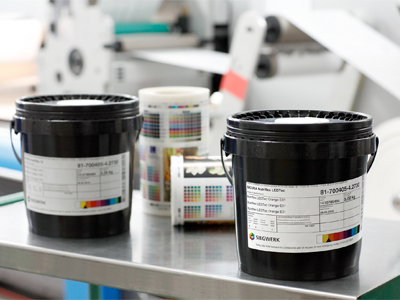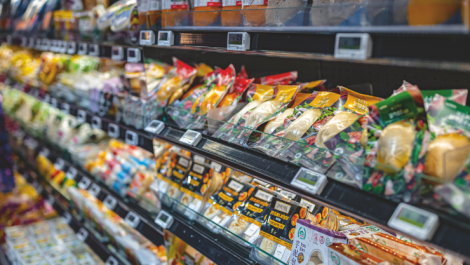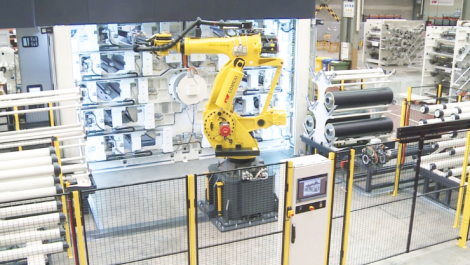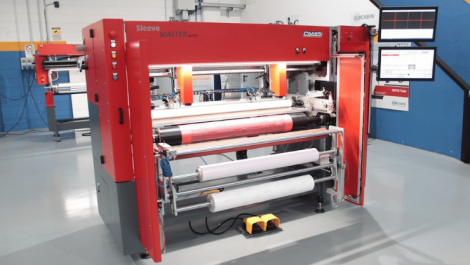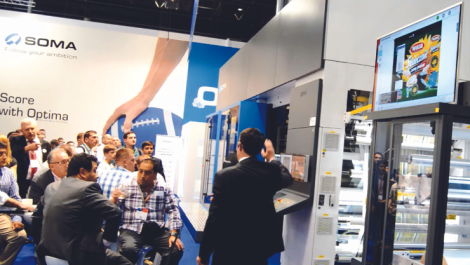Flexo inks from Siegwerk’s SICURA range
Choosing the right ink supplier can be confusing with so many manufacturers on the market, but getting it right is important, as this is a partnership that can bring huge benefits to your business. Neel Madsen spoke to some of the leading suppliers to hear about their latest developments and views of the market.
Colour makes packaging stand out and getting it spot on is paramount. Consumers equate poorly printed packaging with inferior products, and variation in brand colour across the shelf does not impress. Ink suppliers are acutely aware of the demands this puts on their products and the relationship they have with their clients.
Colour science
Colour management is a hot topic, and here the ink supplier can offer invaluable advice and help set up the best possible workflow. ‘It can be a real challenge for printers to achieve repeatable and consistent colour, ensuring that brand and corporate colours are matched accurately, time and time again,’ said Gary Seward, managing director, Pulse Roll Label Products. ‘We have witnessed a growing demand for greater colour control and an increasing requirement from consumer packaged goods companies, as well as the supermarkets for private or own label brands, for colour matching using scientific values.’
To address this trend, the company has the PureTone ink range, which includes a high strength, mono-pigmented mixing system whereby the single pigment formulation makes it easier to colour match due to the reduced total number of pigments used in the mixed ink. This achieves optimised colour strength and cleaner colours and also reduces the potential for metamerisation. The high strength formulation allows for lower film weights of ink resulting in reduced inventory and lower ink volume consumption. It also provides greater flexibility for printing half-tones and full-tones on the same printing plate.
The new range in combination with X-Rite’s InkFormulation Software (IFS) and spectrophotometer offer a solution for colour standardisation, where special colours are created and matched quickly and accurately, eliminating colour variations. Use of the hand-held colour computer, which measures spectral data to provide a higher level of colour accuracy than densitometry alone, combined with IFS is a cloud-based solution for PureTone, which label printers benefit from in terms of fast, accurate and consistent ink formulation, formula creation, storage, approval and retrieval.
In addition, Pulse recommends using RK Print Coat Instruments’ Flexiproof 100 UV proofer, which accurately simulates UV printing for pre-press applications. This complete package provides a total colour management solution that addresses the growing need for colour standardisation and responds to demands from end users for more accurate brand and corporate colours.
Matching service
‘All customers have a choice depending on their individual requirements, but at hubergroup UK, we aim to offer a package and solution for all users, and as we successfully do in other print sectors, look to take costs out of their business by building a partnership,’ commented managing director David Ward. He continued, ‘We are offering a matching service that allows customers to e-mail us requests for either a digital Pantone number or CXF data along with the specs of anilox being used. We will respond with a formulation which has been matched to a Delta E below 0.5, eliminating any press downtime for colour matching.’
hubergroup has just launched a new process set along with the corresponding CRS base scheme, which is mono-pigmented. The pigments have been chosen based on their suitability for the low migration range, which the company will be launching soon, enabling customers with a split production to have continuity in ink mixes for shade, strength and anilox rollers. The NewV CRS inks have been manufactured to be as strong as possible whilst retaining the flow and viscosity attributes required to perform to the highest standard whilst running at speeds up to 150 m/min.
Mr Ward said, ‘Having complete control of the raw materials used in manufacturing, with our own binders and back-integration of the pigment, puts hubergroup in a unique position. The advantage of mono-pigmented inks is the vibrancy and strength that can be achieved when compared to Pantone inks along with a greater colour gamut. The process colours are based on the same back bone and have been developed in accordance with the ink manufacturer’s standard for colour, allowing printers to achieve ISO 12647 in conjunction with the correct volume anilox. Colour control is becoming more prevalent in the narrow web industry you will begin to see customers looking at the process work.’
Whiter than white
The quest to provide the best white continues. For packaging print, a good opaque white is essential. Flexo has traditionally struggled to obtain the high opacity that can be achieved with rotary screen, but in recent years, new products have been brought to market that have done away with this old adage.
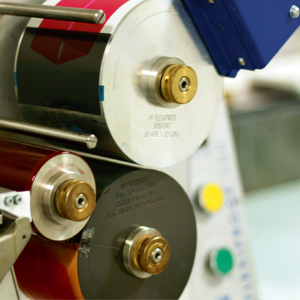
Pulse Roll Label Products recommends using the RK Print Coat FlexiproofUV proofer to simulate the press conditions when colour matching
Mark Bowman, managing director, ColorGen, explained, ‘Opaque whites are big news again. Advances in dispersion technologies are providing greater opacity and brightness of shade, and, coupled with the latest raw materials is allowing our ink formulators the opportunity to create brilliant new products. We are achieving greater opacity with adhesion to traditionally very difficult films, such as metallised and PETs. Our latest products are being used in sachets and pouches, clear on clear and shrink sleeves.’
‘Aniloxes with very high volumes and innovative cell structures are allowing flexo opaque whites to be applied with a level of opacity previously only achievable with the screen process,’ said George Ashmore, technical service manager, narrow web, at Siegwerk UK Ltd. ‘Flexo White E08 is the product we have developed specifically for this application. It has a low viscosity formula designed to release effectively from large, open structured cell engravings.’
Fujifilm’s UVivid UV flexo inks have been developed using Micro-V dispersion technology that guarantees optimised viscosity quality and consistent colour accuracy. Within this range, Supernova White is a key product. It is described as an ultra-opaque flexo printable ink that can replace rotary screen white ink, and allows fine text and opaque solids to be combined on the same plate. Fast cure response, exceptional adhesion and excellent overprinting and trapping properties are its key defining features, according to James Whitehead, product manager at Fujifilm UK, Graphic Systems Division.
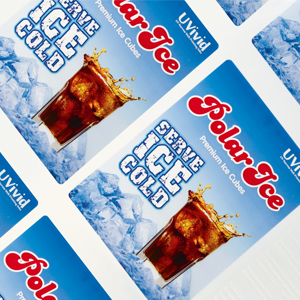
Print sample demonstrating Fujifilm’s UVivid inks
The company has also recently released an upgraded process black ink, designed in direct response to customer demand for inks with higher film rates for use on increasingly faster presses. This enables printers to run higher film weights at faster press speeds whilst still achieving a fully cured ink.
Rayoflex Electron White from Sun Chemical is a fully compliant UV flexo ‘first down’ opaque white low migration ink developed for labels, flexible packaging and sleeves. It is described as having excellent adhesion and resistance, high opacity and printability, being particularly suited to food and pharmaceutical packaging applications. The company has also introduced the SolarFlex Slalom white ink, a reverse printed, high opacity ‘last down’ UV flexo white for shrink sleeves as well as applications such as wraparound labels.
Amanda Jones, business development and marketing director, said that Paragon Inks is about to introduce a newly developed opaque white system, the Titanium series, for supported and unsupported applications. The new range, which promises increased opacity and excellent print performance with reduced pigment, will see its official launch in April.
Low migration
The challenges faced when we are talking about packaging that will come into contact with food are not getting any easier to deal with (for more on food packaging safety, see also pp 53-54). Low migration inks are constantly being developed and improved to meet the ever more stringent legislative demands.
Mr Bowman commented, ‘The term ‘low migration’ is now used to describe anything from the most basic benzophenone/ITX free products, all the way through to the highest speciation of products truly designed to have the lowest potential for migration. Packaging manufacturers are recognising the need for any claim of compliance to be backed up with reliable data that proves, under given conditions, an ink or coating will not migrate within a specific packaging construction.’
Ashland Speciality Ingredients UK, ColorGen’s partner for UV cured coatings, have the capability to provide full analytical data. Ashland recognised that an industry becoming ever more conscious of its need to take the issue of food safety very seriously, would need to see incontrovertible proof, and so, in 2015, it invested more than £1 million in their analytical facility in Bradford; it now has the capability to detect trace amounts of compounds to parts per trillion.
David Ward explained that hubergroup has also seen customer demand this year moving towards the requirement of a full range of low migration products and training to help understand the legislative requirements that need to be met. He said, ‘hubergroup has a wealth of experience with low migration having been at the forefront in the litho market for a number of years. Our MGA brand is well established in the industry for being trusted, and offering products that are developed and manufactured to the highest standard. This is backed up with our in-house testing facility offering the customer support that printers need to be thinking about when choosing an LM ink, as although price has to be a factor, the service, back up and support are just as key.’
Siegwerk has introduced the SICURA Nutriscreen relief varnish, a new low migration UV relief varnish suited to small area printouts on pharmaceutical and food packaging. This transparent and shiny UV relief varnish has been developed specially for tactile warning symbols. ‘The relief varnish stands out for almost imperceptible odour, lowest migration potential, good flexibility and scratching resistance,’ explained George Ashmore. Another example of a low migration ink system offered by Siegwerk is SICURA Nutriflex 10, a UV flexo series suitable for a majority of narrow web applications in the food industry.
‘Due to an increasing awareness of consumers and the continuing upgrading of regulations, the use of UV low migration systems is growing. Siegwerk has accompanied this trend over several years by developing safe products, using a rigorous process for the selection of raw materials. As one of the global market leaders for printing inks, we offer an extensive range of low migration inks, low migration gloss and matt varnishes as well as low migration metallic inks – encompassing the entire sphere of UV printing processes,’ concluded Mr Ashmore.
New in water
Finally there have also been new developments in water-based flexo inks. Siegwerk is now offering a comprehensive water-based ink portfolio, which is new to the UK market and covers high strength variants as well as a full selection of light fast options. ‘Our inks are available in three systems: AquaLabel, a series for applications to paper, and 53-20 for thermal coated substrates as well as Polyaqua for synthetics,’ explained Mr Ashmore.
Ultrachem’s close partnership in the UK and Ireland with ACTEGA Colorchemie continues to go from strength to strength with the successful launch of the latest technology water-based flexo inks, according to Geoff Woodacre, head of the company’s flexo division. These include the new eco friendly AP series for labels, which is virtually maintenance free, with high strength and low viscosity for paper, foil and films. There is also the ColorTissue ink series for printing onto various tissue materials either flexo or gravure. ‘Tissue printing is a very critical field of application in order to comply with statutory provisions and the demanding market requirements; our ink products are thoroughly tested and certified by ISEGA,’ said Mr Woodacre. ‘We are seeing continued success with both the AP and ColorTissue ink systems across various print houses with convertor’s commenting on exceptional ink stability, colour strength with Ultrachem’s technical back up being a major factor in the overall products success.’
Conclusion
But the development work in inks does not stop here. The packaging market continues to grow, both in volume and value, but also in types of applications and packaging formats, and ink technology has to follow suit.
Jonathan Sexton, European sales and marketing director for screen and narrow web, Sun Chemical, said, ‘There is increased competition among label and narrow web printers and converters to capture additional volume in new applications such as flexible packaging. As the choice of substrates continues to expand and end-user applications become more challenging, developments in inks technology have to keep up and anticipate future trends to help printers keep their competitive edge.’
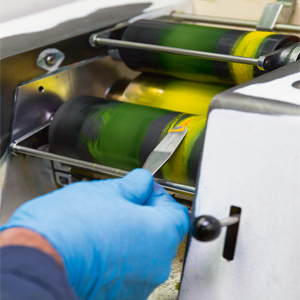
Viscosity test at Ultrachem’s labratory

